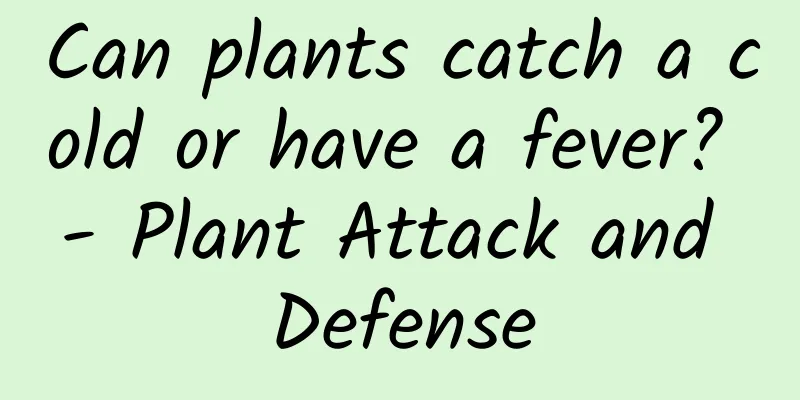Can plants catch a cold or have a fever? - Plant Attack and Defense

|
Produced by: Science Popularization China Author: Gao Kaixing (Institute of Microbiology, Chinese Academy of Sciences) Producer: China Science Expo As autumn arrives late and the seasons change from autumn to winter, we will inevitably hear more sneezing around us, and many people will even have symptoms of fever. This is called an immune response, and it is also a stress response of humans to the external environment, especially the invasion of pathogenic microorganisms. However, have you ever thought about whether plants will also rely on a series of "weapons" such as immune response to defend themselves against such an environment? The answer is yes. This article will take you to explore the offensive and defensive battles between plants and invaders. Remote Magic: Synthesis and Release of Secondary Metabolites As a rare treasure of nature, plants are flexible warriors. When faced with the invasion and interference of pests and pathogenic microorganisms, they will use long-range "magic" and close-range "weapons" to protect themselves from harm. Plant secondary metabolites are a type of plant-specific "magic" attack. They are small molecule organic compounds with certain smells, tastes and toxicity, usually including three categories: terpenes, phenols and nitrogen-containing compounds. Although these substances are invisible and intangible to humans, they have a variety of functions, such as providing early warning signals, avoiding feeding insects, attracting natural enemy insects, reducing insect feeding amount and feeding frequency, inhibiting insect growth and development, affecting insect digestive system, and directly affecting insect "reproduction". They can effectively help plants avoid pests and reduce damage. Fig. 1 Insects have reduced survival rates after feeding on plants producing secondary metabolites (Image source: provided by the author) The long-range defense effects of secondary metabolites are mainly manifested in three aspects: First, plants can rely on secondary metabolites to activate the whole body into a state of combat readiness. In September 2018, researchers from Saitama University in Japan and the University of Wisconsin in the United States discovered that after being traumatized, plants release glutamate as a signal substance of mechanical damage, thereby activating the plant's own systemic defense response in advance and reducing damage from herbivores. Secondly, plants can also warn their "circle of friends" that danger is coming by releasing odor signals. For example, in March 2022, researchers from several scientific research institutions in Japan discovered that mint leaves are damaged after being attacked by herbivores and will release chemical signals of injury. Soybeans and shepherd's purse planted nearby will respond to this chemical signal to upregulate the expression of defense genes in the leaves, activating the anti-herbivore defense system, thereby achieving collaborative resistance among plants. Third, when plants are unable to solve the problem at hand, they will send out a "distress signal" to seek help. Researchers at the Max Planck Institute for Ecology in Germany discovered in 2010 that when tobacco plants are bitten by caterpillars, they are stimulated to release volatile substances in the green leaves, attracting the caterpillars' natural enemies, "bugs," to come forward for a feast, performing a "mantis stalks the cicada, unaware of the oriole behind" drama. Close defense: three magic weapons The "long-range magic" of plants is not omnipotent and cannot resist all herbivores and pathogens that "fight against the wall". At this time, they must have close-fitting "armor" and resistance substances in the body to play a role. The plant defense mechanism can be mainly divided into three parts: (1) Prefabricated barriers The thick epidermal wax, silica and hard cuticle on the surface of the plant form the framework of the armor. Needles, thorns, hooks, hairs and other structures are processed into armor, which effectively reduces the chance of being eaten by animals or reduces the damage caused by eating, and can also effectively prevent the invasion of pathogens. Figure 2 Prefabricated barriers on plant surfaces (Photo source: veer gallery) (2) Plant cell defense When the human body is invaded by pathogens, the white blood cells in the body will come out to secrete a large number of cytokines to attack the invaders. These cytokines act as pyrogens, causing the body to produce a large amount of heat, resulting in symptoms of fever. The same is true for smart plants. The plant immune system can recognize the characteristics of the surface of pathogens/insects and synthesize a series of defensive proteins to block pathogen invasion. Once the threat penetrates deep into the "marrow", the plant must initiate a new round of defense response to protect itself. At this time, the invader will secrete a series of "spears" (effector proteins) to attack the plant defense proteins, and the plant will in turn produce "shields" (anti-disease proteins) to resist the attack. The two sides go back and forth, starting a fierce "reconnaissance and counter-reconnaissance" struggle. If plants cannot suppress pathogens through such basic defense reactions, they will deliberately cause cells around the site of pathogen infection to commit suicide, thereby suppressing the spread of pathogens. This can be seen as an alternative fever response of plants, also known as plant allergic necrosis response. (3) Driving microbial communities The environment in which plants grow is complex, especially in places such as the soil around the roots and the leaf surfaces that are exposed to the air, where there are often a large number of microbial communities. In November 2019, researchers at the Wageningen Ecological Research in the Netherlands found that when pathogenic fungi infect plants, the bacterial communities that coexist with the plants will instead stand up and produce antifungal effectors, that is, the endophytic flora of plants will sense the pathogens and exert resistance [4]; Coincidentally, researchers at the Max Planck Institute for Plant Breeding in Germany found in 2021 that when faced with threats, plants will adopt a "call for help" strategy to recruit beneficial microorganisms in the soil to help them enhance their defense capabilities [5]. These new discoveries all indicate that the microbial resources in the plant environment can serve as a beneficial means of protecting plants in a green and non-toxic manner in the future. From the above content, we can see that although plants cannot move freely like animals to avoid harm, the characteristics of fixed growth have allowed them to acquire many sophisticated protective methods in the long-term evolution process, combining long-range attack and close-range defense to give themselves the most adequate defense mechanism. At present, human beings still need to further explore the understanding of plant defense mechanisms. Small lives often contain great wisdom. Reasonable use of plant's own defense mechanism can help humans protect crops in a green, safe and effective way, reduce economic output losses, and ensure food security system. We also look forward to more sophisticated mechanisms being explored and discovered in the future. Editor: Sun Chenyu References: 【1】Toyota M, Spencer D, Sawai-Toyota S, Jiaqi W, Zhang T, Koo AJ, et al. Glutamate triggers long-distance, calcium-based plant defense signaling. Science. 2018;361:1112-15. https://doi.org/doi:10.1126/science.aat7744 【2】Onosato H, Fujimoto G, Higami T, Sakamoto T, Yamada A, Suzuki T, et al. Sustained defense response via volatile signaling and its epigenetic transcriptional. Plant Physiology. 2022; 189:922-33. https://doi.org/10.1093/plphys/kiac077. 【3】Allmann S, Baldwin IT. Insects betray themselves in nature to predators by rapid isomerization of green leaf volatiles. Science. 2010; 329:1075-78. https://doi.org/doi:10.1126/science.1191634. 【4】Carrión VJ, Perez-Jaramillo J, Cordovez V, Tracanna V, de Hollander M, Ruiz-Buck D, et al. Pathogen-induced activation of disease-suppressive functions in the endophytic root microbiome. Science. 2019;366:606-12. https://doi.org/doi:10.1126/science.aaw9285. 【5】Hou S, Thiergart T, Vannier N, Mesny F, Ziegler J, Pickel B, et al. A microbiota–root–shoot circuit favors Arabidopsis growth over defense under suboptimal light. Nature Plants. 2021;7:1078-92. https://doi.org/10.1038/s41477-021-00956-4. |
<<: The world's first mass-produced solar car has turned yellow? Maybe it never existed...
Recommend
At the end of the year, beware of "fires burning the entire business"... How can small shops pay attention to fire safety?
recently Dalongqinghe Market in Panyu District, G...
How to solve the user retention problem? These 3 dimensions can help you solve it
I heard that your APP has a large number of users...
What are the minefields in Xiaohongshu’s promotion and operation? Getting Started Manual!
Xiaohongshu, which started out as a UGC community...
91 Ten Articles: Tokyo Motor Show announced cancellation, Tesla has caused 175 deaths in eight years
1. Tesla Vice President Tao Lin recently admitted...
Song Yuehan's "Chinese Medicine Syndrome Differentiation Video" teaches you how to accurately diagnose syndromes, and you will understand it after learning it once
Training course video lecture content introductio...
How much does a game server for 10,000 people cost?
How much does a 10,000-game server cost? The rent...
China Association of Automobile Manufacturers: A brief analysis of Chinese brand passenger car sales in June 2022
According to statistics and analysis by the China...
Are your eyes afraid of the cold? Tears keep flowing when the wind blows in winter
Audit expert: Liu Dongbao Chief Physician of Opht...
Human stem cells “space hematopoiesis”, what’s the difference?
On June 4, the return capsule of the Shenzhou 15 ...
How to operate KOL influencer marketing?
As more and more brands use internet celebrities ...
Once the wound heals, the pain is forgotten, so why do scars remain after the wound heals?
Everyone is familiar with "scar physique&quo...
BYD and Huawei jointly release the Leopard 5 Intelligent Driving Edition, and the Formula Leopard opens a new era of national intelligent hard-core
Following the release of BYD's intelligent st...
It's a great diver and a great fisherman! How does the common cormorant dominate the water?
Have you ever seen a black water bird by a river ...
APP Packaging Party’s Business Secrets
Low threshold, zero cost and high income have led...
Why are the results of my bidding promotion getting worse and worse?
Question: I am the manager of online marketing fo...









